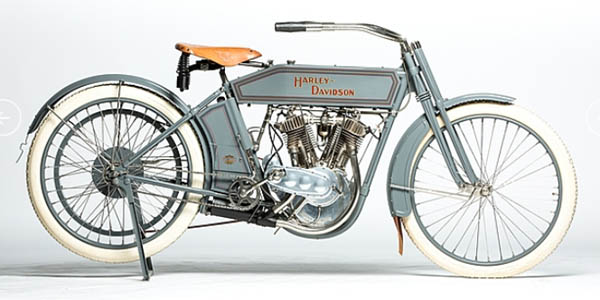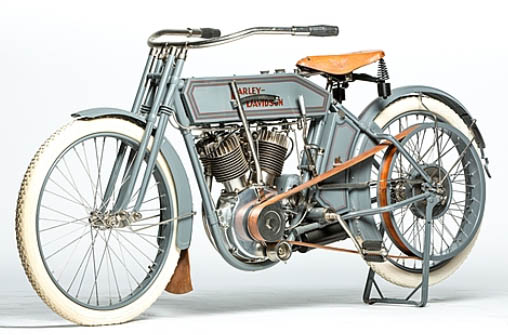The Best of of the EJ Cole Motorcycle AuctionMarch 20-21, 2015 - Las Vegas, Nevada |
Sold for $215,000 on March 21, 2015 The year 1912 was only the second of Harley-Davidson twin-cylinder production, although they had appeared in H-Dís press as early as 1908. Thereís no evidence a twin-cylinder machine was actually sold by the factory until the 1911 model 7D, which differed significantly from the 1908 racer and 1909 Models 5-D (a roadster) and 5-F (the racer). H-D claims 27 of the Model 5 machines were built, but they were likely used for promotion or racing only; no mention of a twin-cylinder model appears in H-D parts books until 1911. As well, the 1908-09 twins used 'atmospheric' inlet valves (i.e. activated by piston suction only, with no camshaft or pushrod), which gave erratic performance in any but a full-throttle position, which would not have suited Harley's already established reputation for reliability and strong running. |
| 1912 HARLEY-DAVIDSON MODEL 8A TWIN | |
|
No V-twin was mentioned in 1910, but in 1911,
a twin reappeared as the Model 7D, which was significantly improved over
the old 'atmospheric' machines. Now both valves per cylinder were
camshaft operated, and as Harley claimed in its brochure, '"Exhaustive
experiments covering more than four years have proved that it is
impossible to get satisfactory results, particularly at low speed, from
a twin-cylinder motor which is equipped with the atmospheric type inlet
valves. The very design of the twin-cylinder type motor is such that
induces misfiring at low speeds. Automatic valves give perfectly
satisfactory results on single-cylinder machines, but the twin
proposition is altogether different," and further, "only features which
have shown their real merit in actual road service will be found in this
machine." Thus we can see our way to safely conclude from the confusion
of first-appearance dates, experimental prototypes, promotional
machines, and non-production racers, that the 1911 7D is indeed the
first 'production' V-twin from Harley-Davidson, and represents the dawn
of a remarkable era in motorcycling. The twin-cylinder H-D had its own frame, distinct from the single-cylinder models, which by 1912 had become a straight downtube as well. Its flat leather belt had the tensioning wheel (or 'idler') introduced for the 1910 singles, which enabled a rider to keep the engine running while at a stop, although of course one risked burning the belt if stopped too long! The top of the cylinder casting now had vertical fins for better cooling and an oil tank sharing the space previously occupied by the toolbox. The magneto had been moved in back of the engine by 1911, out of the path of road grit and water; and in the same vein, Harley applied for a patent for fender skirting which extended over the left side of the wheel, to protect the drive belt from slung mud and water, which caused slippage. This 1912 Harley-Davidson Model 8A is a very rare and very early twin-cylinder model with a belt drive and idler wheel. It was restored from a complete and original machine and was purchased in California. |


